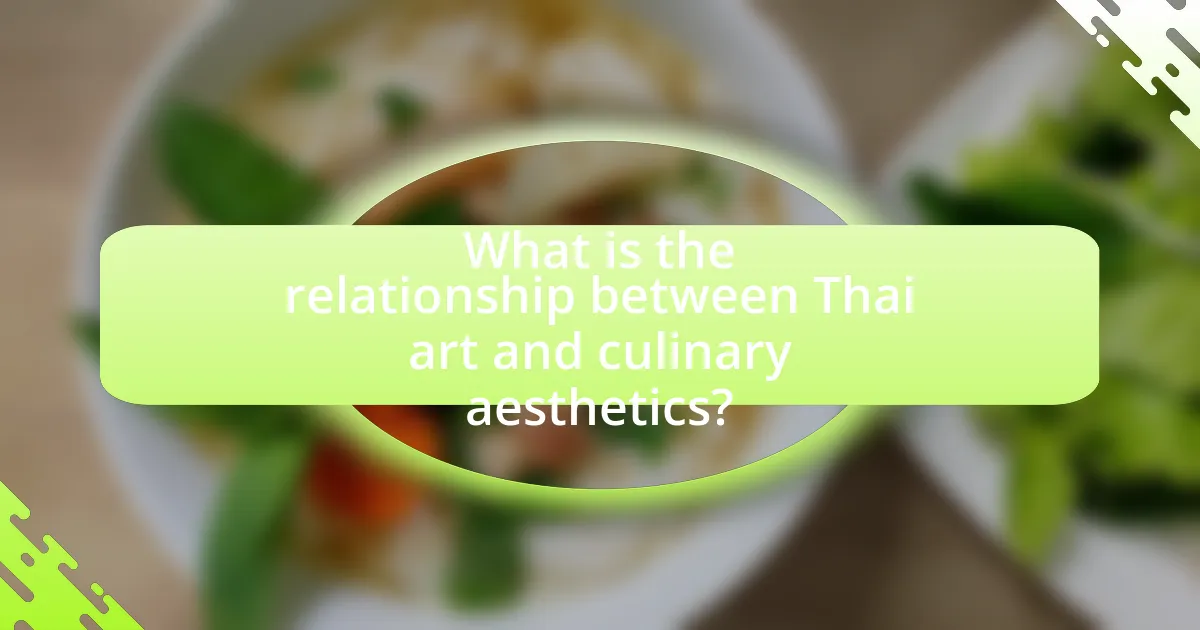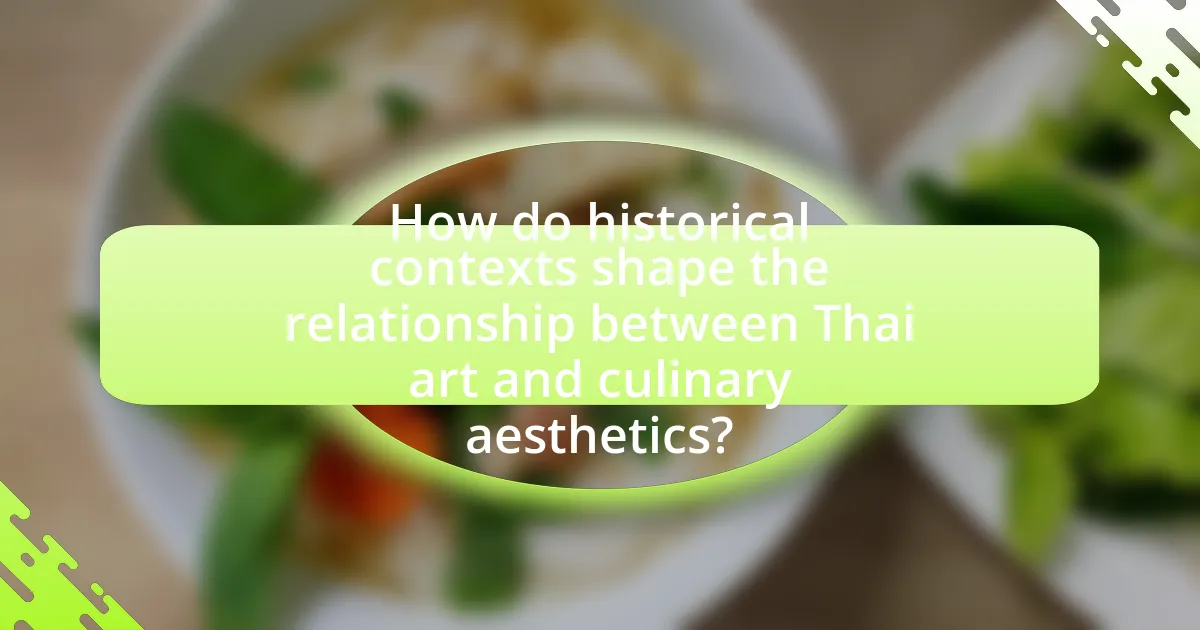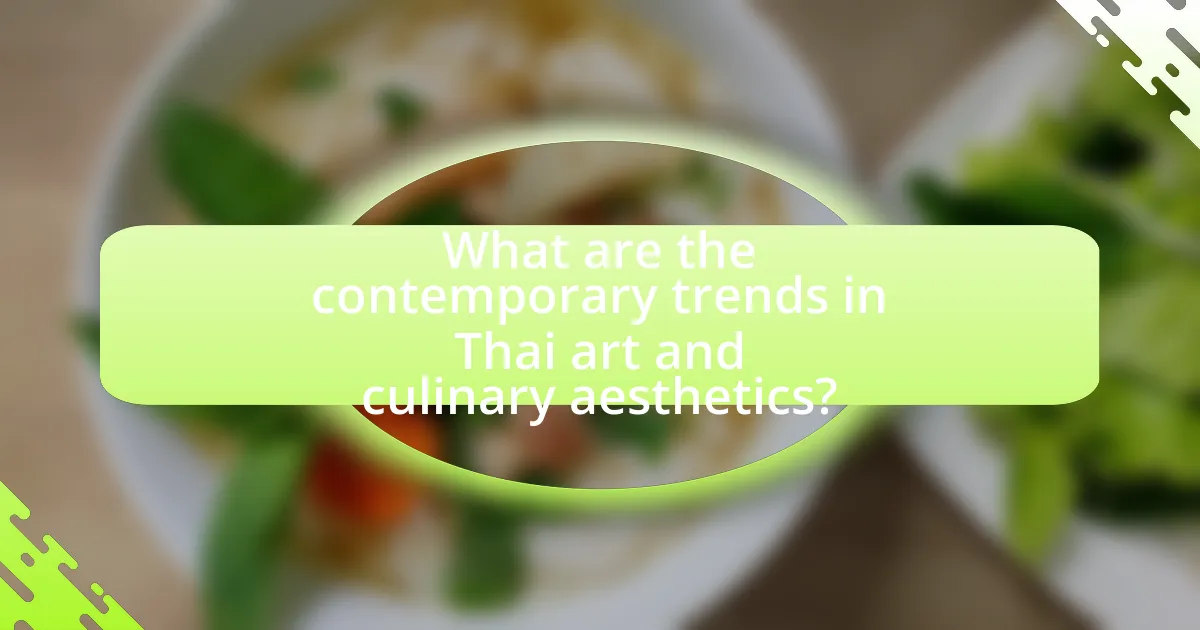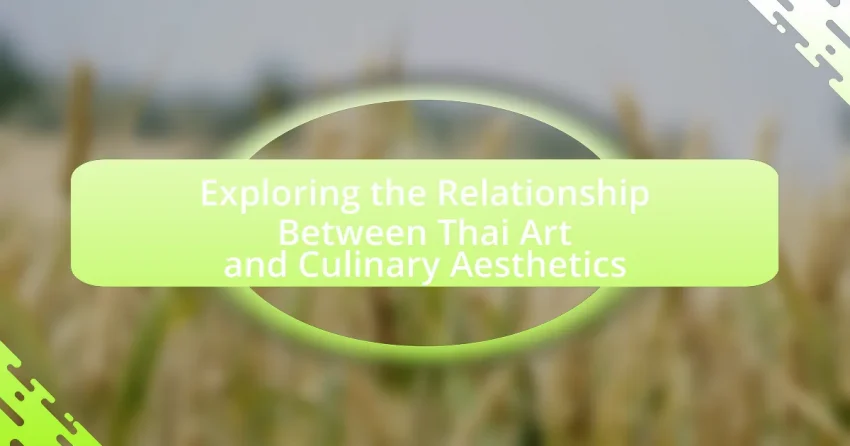The article explores the intricate relationship between Thai art and culinary aesthetics, highlighting how both forms reflect Thailand’s cultural values and traditions. It examines the influence of traditional Thai art on culinary presentation, emphasizing the importance of aesthetics, color theory, and cultural symbolism in food. The discussion includes historical contexts that shaped these connections, regional variations in culinary practices, and contemporary trends that blend traditional techniques with modern interpretations. Additionally, it addresses best practices for integrating art into culinary experiences and the impact of social media on food presentation in Thailand.

What is the relationship between Thai art and culinary aesthetics?
Thai art and culinary aesthetics are deeply intertwined, reflecting the cultural values and traditions of Thailand. Both forms emphasize beauty, harmony, and attention to detail, with Thai cuisine often presented as a visual art form that mirrors the intricate designs found in traditional Thai art. For example, the vibrant colors and meticulous arrangements of ingredients in dishes like Pad Thai or Som Tum echo the elaborate patterns seen in Thai textiles and sculptures. This relationship is further supported by the historical context, where royal courts promoted both artistic expression and culinary refinement, leading to a rich cultural heritage that celebrates the aesthetic experience in both art and food.
How do Thai art forms influence culinary presentation?
Thai art forms significantly influence culinary presentation by emphasizing aesthetics, color, and intricate designs. Traditional Thai art, characterized by vibrant colors and detailed patterns, inspires chefs to create visually appealing dishes that reflect cultural heritage. For instance, the use of edible flowers and decorative garnishes in Thai cuisine mirrors the ornamental aspects of Thai sculpture and painting, enhancing the visual experience of the meal. This connection is evident in the presentation of dishes like Pad Thai and Som Tum, where the arrangement and colors are carefully curated to evoke the beauty found in Thai art. The integration of these artistic elements not only elevates the dining experience but also serves to communicate cultural narratives through food.
What specific art styles are reflected in Thai cuisine?
Thai cuisine reflects several specific art styles, notably traditional Thai painting, sculpture, and decorative arts. The intricate presentation of dishes often mirrors the detailed patterns found in traditional Thai textiles and ceramics, showcasing vibrant colors and elaborate designs. For instance, the use of garnishes and the arrangement of food on the plate can resemble the ornate motifs seen in Thai murals and temple decorations, emphasizing harmony and balance. Additionally, the influence of Buddhist art is evident in the symbolic use of ingredients and the aesthetic principles of symmetry and proportion, which are central to both culinary and visual arts in Thailand.
How does color theory in Thai art apply to food presentation?
Color theory in Thai art significantly influences food presentation by emphasizing vibrant colors that evoke emotions and enhance visual appeal. In Thai culture, colors are associated with specific meanings; for example, red symbolizes happiness and prosperity, while green represents freshness and health. This cultural understanding is applied in food presentation, where dishes are arranged to showcase a harmonious blend of colors, creating an inviting and appetizing appearance. The use of contrasting colors, such as bright garnishes against neutral backgrounds, draws attention to the food and enhances the overall dining experience. This practice aligns with the principles of Thai art, where color combinations are carefully selected to convey beauty and balance, ultimately enriching the culinary aesthetic.
Why is aesthetics important in Thai culinary traditions?
Aesthetics is important in Thai culinary traditions because it enhances the overall dining experience and reflects cultural values. The visual presentation of food in Thailand often incorporates vibrant colors, intricate designs, and artistic arrangements, which not only appeal to the senses but also signify respect for the ingredients and the act of sharing a meal. This emphasis on aesthetics is rooted in Thai culture, where food is seen as a form of art and a means of expressing hospitality. For instance, traditional Thai dishes are often garnished with fresh herbs and flowers, showcasing the importance of beauty in culinary practices.
How does visual appeal enhance the dining experience in Thai culture?
Visual appeal significantly enhances the dining experience in Thai culture by creating an immersive sensory environment that engages diners. The presentation of food in Thailand often incorporates vibrant colors, intricate designs, and artistic arrangements, reflecting the country’s rich artistic heritage. For instance, dishes are frequently garnished with fresh herbs and vegetables, which not only add flavor but also enhance visual aesthetics, making the meal more inviting. This emphasis on visual presentation is rooted in Thai cultural values that prioritize beauty and harmony, as seen in traditional Thai art forms. Studies indicate that visually appealing meals can increase appetite and satisfaction, reinforcing the importance of aesthetics in culinary experiences.
What role does cultural symbolism play in the aesthetics of Thai food?
Cultural symbolism plays a crucial role in the aesthetics of Thai food by infusing dishes with meanings that reflect Thailand’s history, beliefs, and social values. For instance, the use of vibrant colors in Thai cuisine, such as the bright red of chili or the green of fresh herbs, symbolizes the importance of balance and harmony, which are central to Thai culture. Additionally, traditional ingredients like lemongrass and kaffir lime leaves are not only chosen for their flavors but also for their cultural significance, often associated with health and wellness in Thai society. The presentation of food, often arranged artfully on the plate, reflects the Thai belief in the beauty of nature and the importance of visual appeal, which is a key aspect of Thai art. This aesthetic approach is supported by the historical context of Thai culinary practices, where food is seen as a form of art that embodies the country’s rich cultural heritage.

How do historical contexts shape the relationship between Thai art and culinary aesthetics?
Historical contexts significantly shape the relationship between Thai art and culinary aesthetics by intertwining cultural, religious, and historical influences that reflect societal values. For instance, the influence of Buddhism in Thailand has led to the incorporation of symbolic elements in both art and food presentation, where intricate designs in dishes often mirror the ornate patterns found in traditional Thai art forms, such as temple murals and sculptures. Additionally, the Ayutthaya and Sukhothai periods, known for their artistic advancements, also saw the evolution of culinary practices that emphasized aesthetics, with dishes being crafted to appeal visually as well as tastefully, showcasing the importance of presentation in Thai culture. This historical interplay illustrates how art and culinary practices are not only forms of expression but also serve as a reflection of Thailand’s rich cultural heritage.
What historical events influenced the development of Thai culinary aesthetics?
The development of Thai culinary aesthetics has been significantly influenced by historical events such as the establishment of the Ayutthaya Kingdom in the 14th century, which facilitated trade and cultural exchange with foreign nations. This period introduced diverse ingredients and cooking techniques from China, India, and Persia, enriching Thai cuisine. Additionally, the influence of the Sukhothai Kingdom, known for its emphasis on presentation and balance in food, laid the groundwork for the aesthetic principles that characterize Thai culinary art today. The integration of Buddhist philosophy during these periods also emphasized harmony and mindfulness in food preparation and presentation, further shaping the culinary aesthetics of Thailand.
How did the introduction of foreign influences alter Thai art and cuisine?
The introduction of foreign influences significantly altered Thai art and cuisine by incorporating diverse styles, techniques, and ingredients. For instance, during the Ayutthaya period, interactions with Portuguese, Dutch, and Chinese traders introduced new culinary practices and ingredients such as chili peppers and tomatoes, which became staples in Thai cooking. In art, the influence of Western techniques during the Rattanakosin period led to the integration of perspective and realism in traditional Thai painting, as seen in the murals of Wat Phra Kaew. These changes reflect a blend of indigenous and foreign elements, enriching both the aesthetic and gastronomic landscape of Thailand.
What traditional practices have persisted in modern Thai culinary aesthetics?
Traditional practices that have persisted in modern Thai culinary aesthetics include the use of fresh herbs, intricate presentation, and communal dining. Fresh herbs such as basil, cilantro, and lemongrass remain central to Thai dishes, enhancing flavor and aroma. The intricate presentation of food, often resembling art, reflects the cultural emphasis on beauty and balance, a practice rooted in historical Thai customs. Additionally, communal dining, where dishes are shared among family and friends, continues to be a significant aspect of Thai culture, promoting social interaction and connection. These practices are supported by the enduring popularity of traditional Thai recipes and the cultural significance placed on food in Thai society.
How do regional variations in Thailand affect culinary aesthetics?
Regional variations in Thailand significantly influence culinary aesthetics by shaping the ingredients, presentation, and flavor profiles unique to each area. For instance, northern Thai cuisine often features milder flavors and a focus on fresh herbs, while southern Thai dishes are known for their bold, spicy profiles and the use of coconut milk. This diversity in taste is reflected in the visual presentation of dishes, where colors and textures vary according to local ingredients, such as the vibrant greens of fresh herbs in the north versus the rich reds and yellows of southern curries. Additionally, cultural practices and local traditions further enhance the aesthetic experience, as seen in the elaborate food displays during festivals in central Thailand, which emphasize artistry and craftsmanship. Thus, the interplay of regional ingredients, flavor preferences, and cultural practices collectively shapes the culinary aesthetics across Thailand.
What are the distinct artistic styles found in different Thai regions?
Distinct artistic styles in different Thai regions include the intricate gold leaf and mural paintings of Central Thailand, particularly in Bangkok and Ayutthaya, which reflect Buddhist themes. Northern Thailand is known for its Lanna style, characterized by wood carvings and unique temple architecture, often adorned with vibrant colors and intricate details. Northeastern Thailand showcases the Isan style, which incorporates local materials and motifs, often seen in silk weaving and pottery. Southern Thailand features a blend of Malay influences, evident in its batik textiles and traditional boat designs. Each region’s artistic style is deeply rooted in its cultural and historical context, showcasing the diversity of Thai art.
How do local ingredients influence the presentation of Thai dishes?
Local ingredients significantly influence the presentation of Thai dishes by enhancing visual appeal and authenticity. The vibrant colors of fresh herbs, vegetables, and spices, such as red chili, green basil, and yellow turmeric, create a visually striking plate that reflects the natural beauty of Thailand’s landscape. Additionally, the use of local ingredients allows for traditional plating techniques, such as garnishing with edible flowers or intricate vegetable carvings, which are rooted in Thai culinary culture. This emphasis on aesthetics not only showcases the freshness and quality of the ingredients but also aligns with the Thai philosophy of balancing taste, texture, and visual presentation, making each dish a work of art.

What are the contemporary trends in Thai art and culinary aesthetics?
Contemporary trends in Thai art and culinary aesthetics emphasize a fusion of traditional techniques with modern interpretations, showcasing vibrant colors and intricate designs. In art, there is a growing movement towards incorporating digital media and installation art, reflecting Thailand’s cultural heritage while appealing to global audiences. In culinary aesthetics, chefs are increasingly focusing on presentation, using artistic plating techniques that highlight the freshness and vibrancy of ingredients, often inspired by traditional Thai motifs. This trend is supported by the rise of social media, where visually appealing dishes gain popularity, influencing culinary practices.
How are modern chefs incorporating traditional Thai art into their culinary practices?
Modern chefs are incorporating traditional Thai art into their culinary practices by using intricate plating techniques that reflect the aesthetics of Thai visual art. This includes the use of vibrant colors, detailed garnishing, and the arrangement of food to mimic traditional Thai motifs, such as floral patterns and geometric designs. For instance, chefs often employ edible flowers and herbs to create visually stunning dishes that pay homage to the traditional Thai art of flower arranging, known as “phuang malai.” This approach not only enhances the visual appeal of the dishes but also connects diners to the cultural heritage of Thailand, reinforcing the importance of aesthetics in both art and cuisine.
What innovative techniques are being used to enhance food presentation?
Innovative techniques enhancing food presentation include the use of edible flowers, molecular gastronomy, and artistic plating. Edible flowers add vibrant colors and unique flavors, elevating visual appeal and taste. Molecular gastronomy employs scientific methods to transform textures and forms, creating visually striking dishes that surprise diners. Artistic plating focuses on the arrangement of food elements, utilizing negative space and contrasting colors to create a visually balanced and appealing presentation. These techniques are increasingly adopted in culinary practices, particularly in fine dining, to create memorable dining experiences that reflect the aesthetics of Thai art.
How do social media and digital platforms influence culinary aesthetics in Thailand?
Social media and digital platforms significantly influence culinary aesthetics in Thailand by promoting visually appealing food presentations and encouraging creative culinary expressions. Platforms like Instagram and Facebook allow chefs and food enthusiasts to showcase vibrant dishes, leading to trends that prioritize aesthetics alongside taste. For instance, the rise of “food styling” in Thailand has been documented, where dishes are meticulously arranged and photographed to attract online attention, reflecting a shift in how food is perceived culturally. This visual emphasis has resulted in increased competition among restaurants to create Instagram-worthy meals, ultimately shaping the culinary landscape in Thailand.
What best practices can be adopted for integrating art into culinary experiences?
Integrating art into culinary experiences can be effectively achieved by employing visual presentation, thematic design, and interactive elements. Visual presentation involves arranging food in aesthetically pleasing ways, such as using vibrant colors and artistic plating techniques, which enhances the dining experience and engages the senses. Thematic design incorporates cultural or artistic motifs that reflect the culinary tradition, such as using traditional Thai patterns in table settings or serving dishes that echo local art forms. Interactive elements, such as live cooking demonstrations or art-inspired food workshops, foster engagement and create memorable experiences for diners. These practices not only elevate the culinary experience but also celebrate the cultural significance of art in food, as seen in Thai cuisine, where presentation is integral to the dining ritual.
How can restaurants effectively showcase Thai art in their dining environments?
Restaurants can effectively showcase Thai art in their dining environments by incorporating traditional Thai artwork, such as paintings, sculptures, and textiles, into their decor. This integration not only enhances the visual appeal but also creates an immersive cultural experience for diners. For instance, using handcrafted Thai ceramics for table settings or displaying local artists’ paintings on the walls can reflect the rich heritage of Thai art. Additionally, restaurants can host art exhibitions or collaborate with Thai artists to feature rotating displays, thereby engaging the community and promoting cultural appreciation. This approach aligns with the growing trend of experiential dining, where the ambiance significantly contributes to the overall dining experience.
What tips can chefs follow to create visually appealing Thai dishes?
Chefs can create visually appealing Thai dishes by incorporating vibrant colors, diverse textures, and artistic plating techniques. Utilizing fresh ingredients like herbs, vegetables, and spices not only enhances flavor but also adds visual interest; for example, the bright green of Thai basil or the red of chili peppers can make a dish pop. Additionally, arranging food in a way that highlights its natural shapes and colors, such as stacking or layering components, can create an eye-catching presentation. The use of garnishes, like edible flowers or finely sliced vegetables, can further elevate the visual appeal. Research indicates that presentation significantly influences diners’ perceptions of taste, emphasizing the importance of aesthetics in culinary experiences.
